Report on Joint Research Findings
Fiscal 2020
Principal Research
1. A Study of the Collection of the Autographed Manuscripts of Minoru Betsuyaku
Selected Research
1. Foundational Research on the Ernie Pyle Theater Based on the Senda Collection: A Record of Michio Ito’s Dance Practice and Genre-Crossing Performances from 1946 to 1948
2. Research on Musicians and Musical Bands through Kurihara’s Musical Score Collection: Music for Stage and Cinema during the Early Showa Era
3. The Basic Research of Silent Film Screenings Using Promotional Movie Materials
4. A Comprehensive Study of Actor Picture Books
5. The Basic Research of Tokiwazu-bushi Woodblock Printings Formerly Owned by Sakagawaya
Principal Research 1
A Study of the Collection of the Autographed Manuscripts of Minoru Betsuyaku
Principal Researcher
Itsuki Umeyama (Associate Professor, Department of Performing Arts, Faculty of Literature, Arts and Cultural Studies, Kindai University)
Collaborative Researchers
Minako Okamuro (Professor, Faculty of Letters, Arts, and Sciences, Waseda University, and Director, Theatre Museum, Waseda University)
Ryuki Goto (Assistant Professor, Theatre Museum, Waseda University)
Research Objectives
This study verifies the writing style of Japanese playwright Minoru Betsuyaku through the survey of the Collection of the Autographed Manuscripts of Minoru Betsuyaku, donated in 2019, and materials related to his works. When Betsuyaku first started writing, he was influenced by the Theatre of the Absurd, as exemplified by playwright Samuel Beckett, while simultaneously taking an interest in the literary works of the likes of Kenji Miyazawa, nursery rhymes, songs, and oldstyle poems, incorporating them into his writings. This practice became even more pronounced from the late 1990s onward. In this study, we confirm which nontheatrical writings influenced Betsuyaku’s own style and how they connect to the theatrical structure and sense of language Betsuyaku acquired from the Theatre of the Absurd.
Summary of Research
The Collection of the Autographed Manuscripts of Minoru Betsuyaku mainly comprises drafts of theatrical works. After being donated, it was organized by Ryuki Goto, who is also a co-researcher of the present study. The unpublished works contained therein gained significant interest after being published in the magazines in 2020. Thirty-seven of the 101 manuscripts remain unpublished, and there are additional donated materials that have yet to be examined.
This year, a total of five material surveys were conducted, as well as interviews with Mr. Akihito Noda, one of the former editors of the special interest magazine Kikan hyoron (Quarterly Review, 1969–1986), in which Betsuyaku was deeply involved. Kikan hyoron is a valuable resource for identifying how Betsuyaku was influenced by the Theatre of the Absurd through his review work. Mr. Noda kindly advised us on other people with whom we could talk about Betsuyaku’s influence upon this magazine. We hope to conduct interviews with these people as soon as possible next year, when the COVID-19 situation has improved.
This year’s material survey has not been scrutinized in detail, as it is intended as a big-picture assessment. However, it clearly contains important materials related to Betsuyaku’s early works from the 1960s. Additionally, valuable materials were discovered that traced his writing process from start to finish, including collected texts from his teenage years, creative writing notebooks believed to be from his 20s, and a map Betsuyaku himself worked on for his Soyosoyozoku series.
Next year, we plan to carefully examine the collection with a focus on these valuable materials, while simultaneously holding a Minoru Betsuyaku exhibition as a special event of the Theatre Museum, accompanied by a wide release of survey results. We would like to thank the secretariat of the Center for their cooperation in the undertaking of this study. We also greatly appreciate the cooperation of the museum staff in organizing the materials, which allowed the survey to
proceed efficiently.

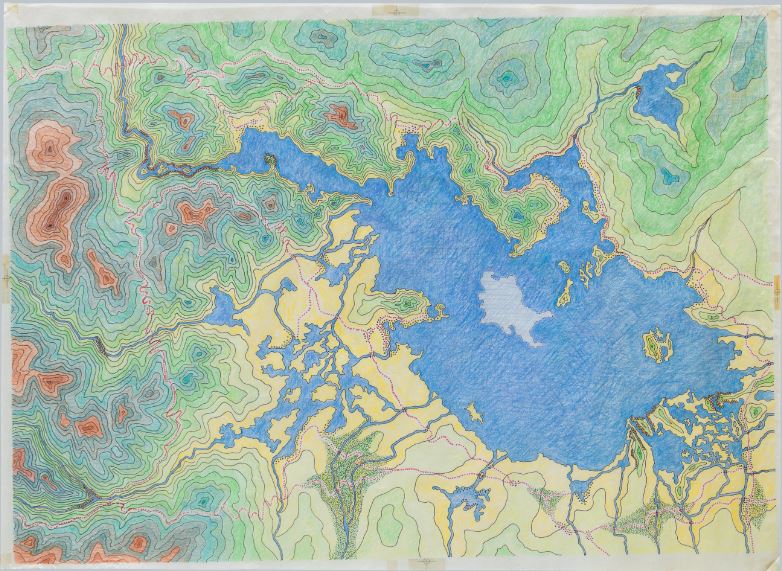
(L) Creative writing notebooks
(R) Soyosoyozoku map
Selected Research 1
Foundational Research on the Ernie Pyle Theater Based on the Senda Collection: A Record of Michio Ito’s Dance Practice and Genre-Crossing Performances from 1946 to 1948
Principal Researcher
Kiyomi Kushida (Associate Professor, Department of Aesthetics and Art History, Jissen Women’s University)
Collaborative Researchers
Sayaka Yamada (Assistant Professor, Department of Child Studies, Japan Women’s University)
Tara Rodman (Assistant Professor, Department of Drama, Claire Trevor School of the Arts, University of California, Irvine)
Research Objectives
The Ernie Pyle Theater was an Allied recreation facility during the postwar occupation period. It operated from December 24, 1945, to January 27,1955, in the occupied Tokyo Takarazuka Theater. The artistic director of the theater, Michio Ito (1893–1961), was the older brother of actor and director Koreya Senda and had been active on Broadway and in Hollywood. The purpose of this study is to survey and analyze the materials related to Michio Ito contained in the Koreya Senda collection, in particular those concerning the Ernie Pyle Theater. Our aim is to reexamine the dance works of Ito, whose productions traversed various genres in postwar Japan.
Summary of Research
This year, we are proceeding with the digitization and cataloging of materials in the Senda Collection related to Michio Ito (hereafter, “J materials”), as well as surveying and examining materials that have already been digitized. The materials receiving particular attention in this study include documents related to the Ernie Pyle Theater, photographs related to Michio Ito and the resident dance troupe at the theater, scrapbooks featuring newspaper and journal articles, the script for “Tabasco,” and Michio Ito’s stage notes. By investigating these materials, we were able to clarify information about the internal management structure and production system of the Ernie Pyle Theater. Furthermore, we identified with relative certainty thirteen works that were created by the Japanese stage production staff and five that were created by Michio Ito between 1946 and the early half of 1948.
Rodman and Kushida, who are surveying the photographic records included in the Senryō-ki Nihon kanren shiryō (“Materials related to Occupied Japan”) held by the US National Archives and Records Administration, concurrently conducted a comparative study of both sets of material in order to substantiate and accurately identify the works that were performed. The results showed that the photographs within the J materials do not match the photographic records of
the US National Archives and Records Administration, although similar photos are included in both collections.
Based on the above, we held an interim team briefing at the end of December. Having investigated the photographs of the Ernie Pyle Theater, Rodman referred to the connection between the characteristics of Michio Ito’s repertory and dance style, his performed works, and the US Latin music and cultural boom. Specifically, she indicated that certain photographs in the J materials, which bear the stamp of the US Army Signal Corps on the reverse side, would have been recorded by Signal Corps photographers to report back to the US on the conditions in occupied Japan. She also noted that the contemporary US “Latin boom” could be attributed to policies of the “Good Neighbor” era under the Roosevelt administration. The cheerfully unfolding Latin dance and rhythms of Ito’s production “Tabasco” can thus be considered as devices to immerse the occupying soldiers in a moment of nostalgia and bliss.
Kushida used photographs from the J materials to identify the works and their periods of performance, finding that each set of materials contained different types of photographs in no particular order. By creating a chronological table of the performances, Kushida was able to confirm that they were strategically ordered in line with the development of Ito’s resident dance company, which was formed through open recruitment. The table revealed that the performances proceeded
chronologically in order of difficulty, beginning with “Japanese-style” pieces, progressing through folk dances, and finally moving to pieces in the “Western style.” Kushida’s results are summarized in “Stage Shows at the Ernie Pyle Theater” (Jissen Women’s University Aesthetics and Art History, vol. 35, March 2021), and “The Production and Characteristics of Michio Ito’s Dance Works: an Investigation of Stage Shows at the Ernie Pyle Theater Based on the Testimony of Those Involved” (The Faculty of Letters of Jissen Women’s University, Annual Reports of Studies, vol. 63, March 2021).
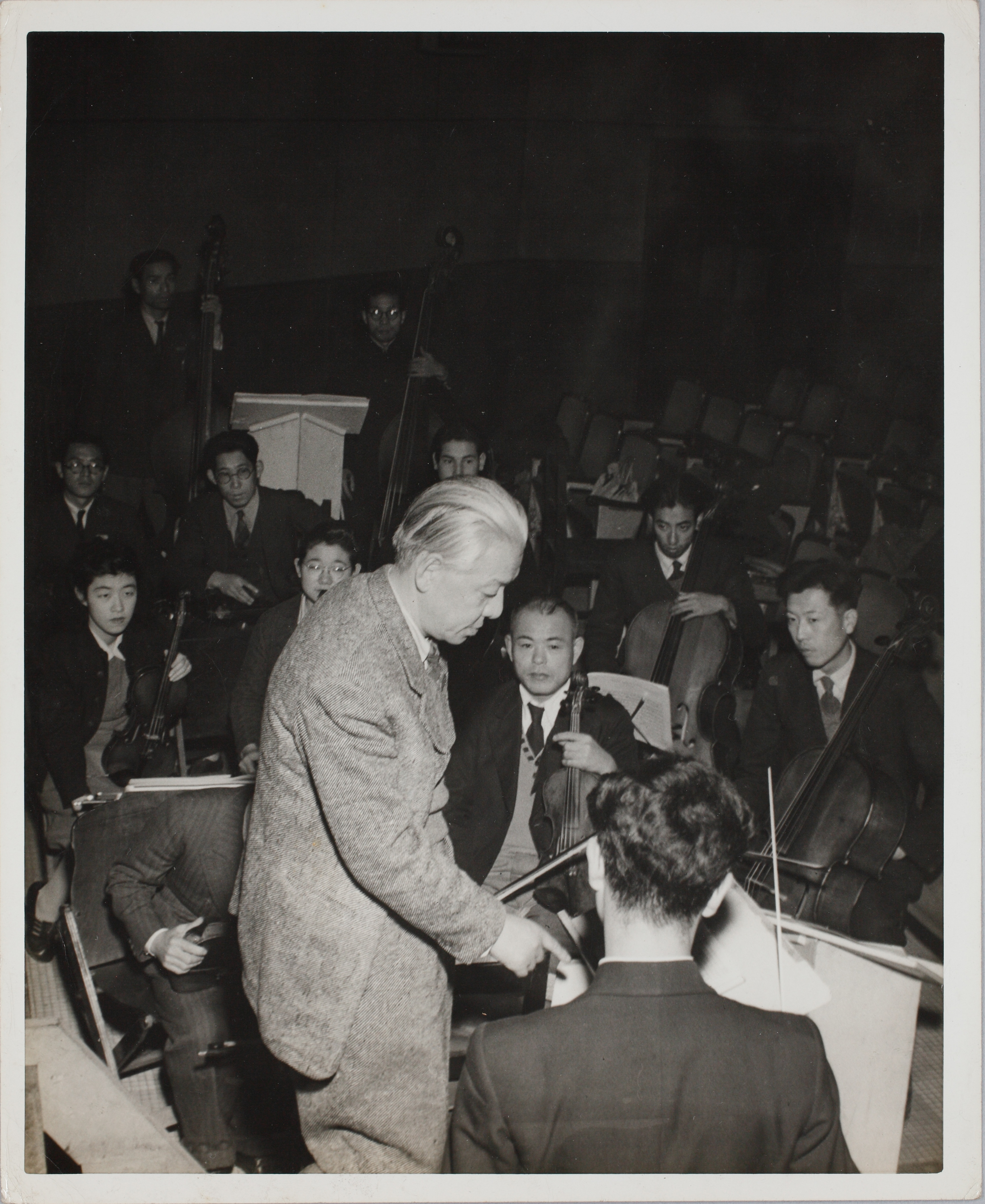
Michio Ito and the Ernie Pyle Orchestra (December 6, 1946)[SND-J5-017_01]
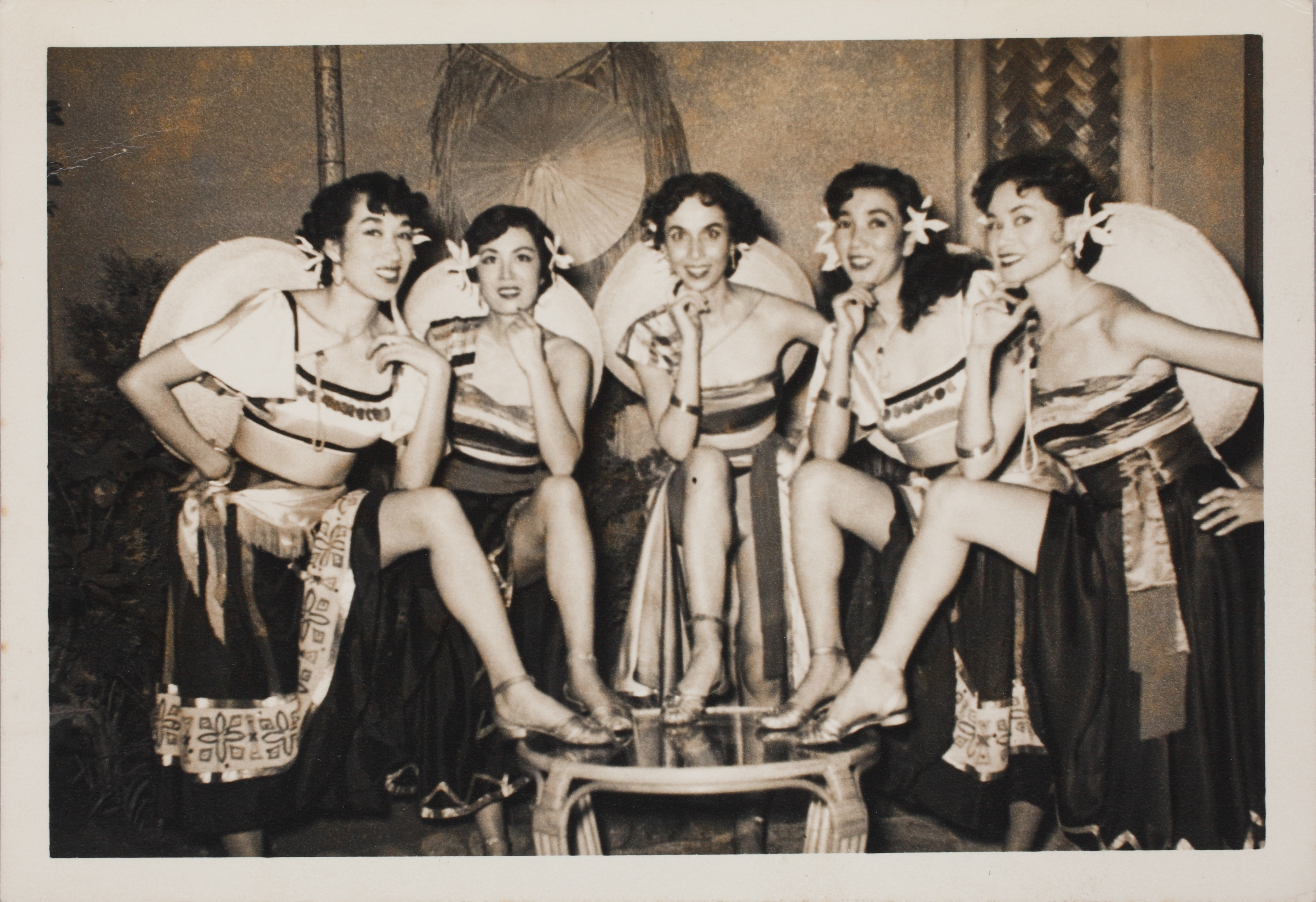
The "Erniettes" resident dance troupe posing in South American-style costumes[SND-J1-12_014_014_01]
Selected Research 2
Research on Musicians and Musical Bands through Kurihara’s Musical Score Collection: Music for Stage and Cinema during the Early Showa Era
Principal Researcher
Masaaki Nakano (Affiliated Lecturer, School of Arts and Letters, Meiji University)
Collaborative Researchers
Fumito Shirai (Lecturer, School of World Liberal Arts, Nagoya University of Foreign Studies)
Yohei Yamakami (Project Lecturer, Komaba Organization for Educational Excellence, The University of Tokyo)
Masato Mori (Independent Researcher)
Hiroyuki Kojima (Doctoral Program, Graduate School of Arts and Sciences, the University of Tokyo)
Research Objectives
Shigekazu Kurihara (1897–1983) was a musician who was active during the early Showa period in the Enoken Orchestra and Shochiku Kinema’s performance department, as well as the P.C.L. (Photo Chemical Laboratory) Film Studio in the early days of sound films. This study surveys and analyzes musical scores formerly belonging to the Enoken Orchestra and Shigekazu Kurihara (approximately 1,000 items). It uses the results of a basic survey of musical score material (approximately 700 items) conducted up to 2019 to combine contemporary documents and a survey of related musical score collections. Its aim is to use empirical research on the activities of Kenichi Enomoto (1904–1970) and other contemporaneous musicians and orchestras with whom Kurihara worked and, thereby, to broadly elucidate the creation and performances of contemporary theaters, music, and films across a wide range of genres.
Summary of Research
〇 Survey and analysis of musical score materials
Through a two-year research project ending last year, we created a catalog of 700 musical scores formerly belonging to Kurihara, including materials from both the initial purchase in 2016 and the second purchase made in 2017. We successfully surveyed the materials, which contain a mix of imported scores and manuscripts for different works. This year, mainly through the efforts of collaborative researcher Kojima, we created a catalog of digitized items and summarized approximately 200 new materials in the museum.
The newly digitized materials mainly include musical scores found in surveys prior to last year and similar printed scores and manuscripts. Based on the results of interviews with Mr. Masahisa Segawa in 2019 and further surveys, it is highly likely that this collection includes scores that were originally from other collections but were later mixed after being transferred to Segawa following Kurihara’s death. The progress of a systematic survey of the ownership stamps and musical scores enabled us to clarify the process by which these materials were collected, stored, and used. In the future, we plan to connect these findings to a survey of details about the writing, such as performance instructions and lyrics translated into Japanese.
〇 The digitization and examination of musical score collections and related materials from the same era
Of the materials formerly belonging to Segawa, we digitized materials related to Shigeya Kikuchi, a musician active in the same period as Kurihara, and a photo album related to Enomoto’s stage performances, which was purchased last year. Furthermore, through internal online meetings, we convened a study session for the purpose of completing a report, which is to be held on February 15, 2021, and proceeded to examine the Kurihara collection and related materials. Despite
the difficulties stemming from the COVID-19 crisis, some results have been achieved by cataloging via digitized materials and online meetings. In the future, we would like to explore how we might continue to conduct interview surveys, utilize performances and screenings to study musical scores, and conduct surveys at relevant museums.
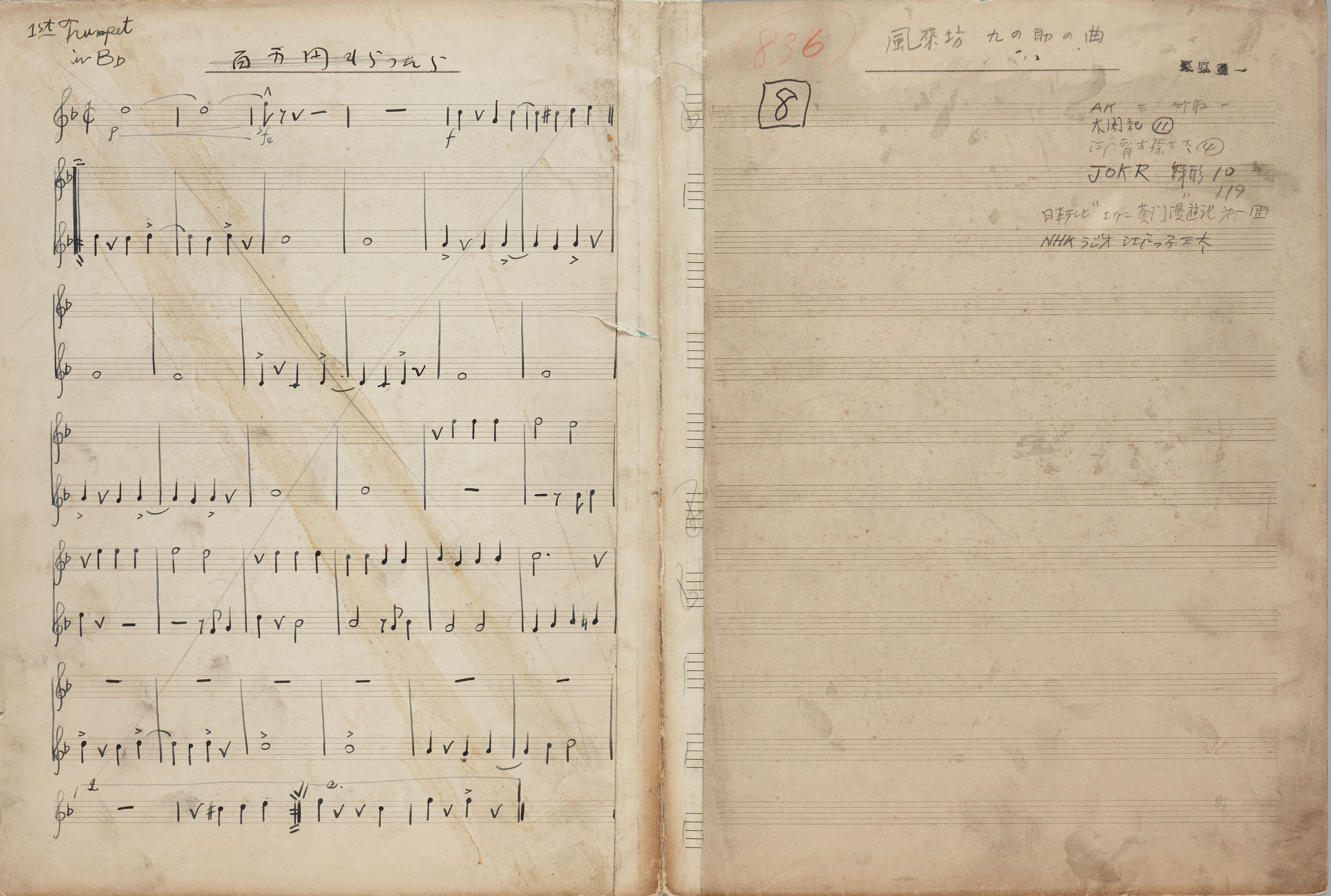
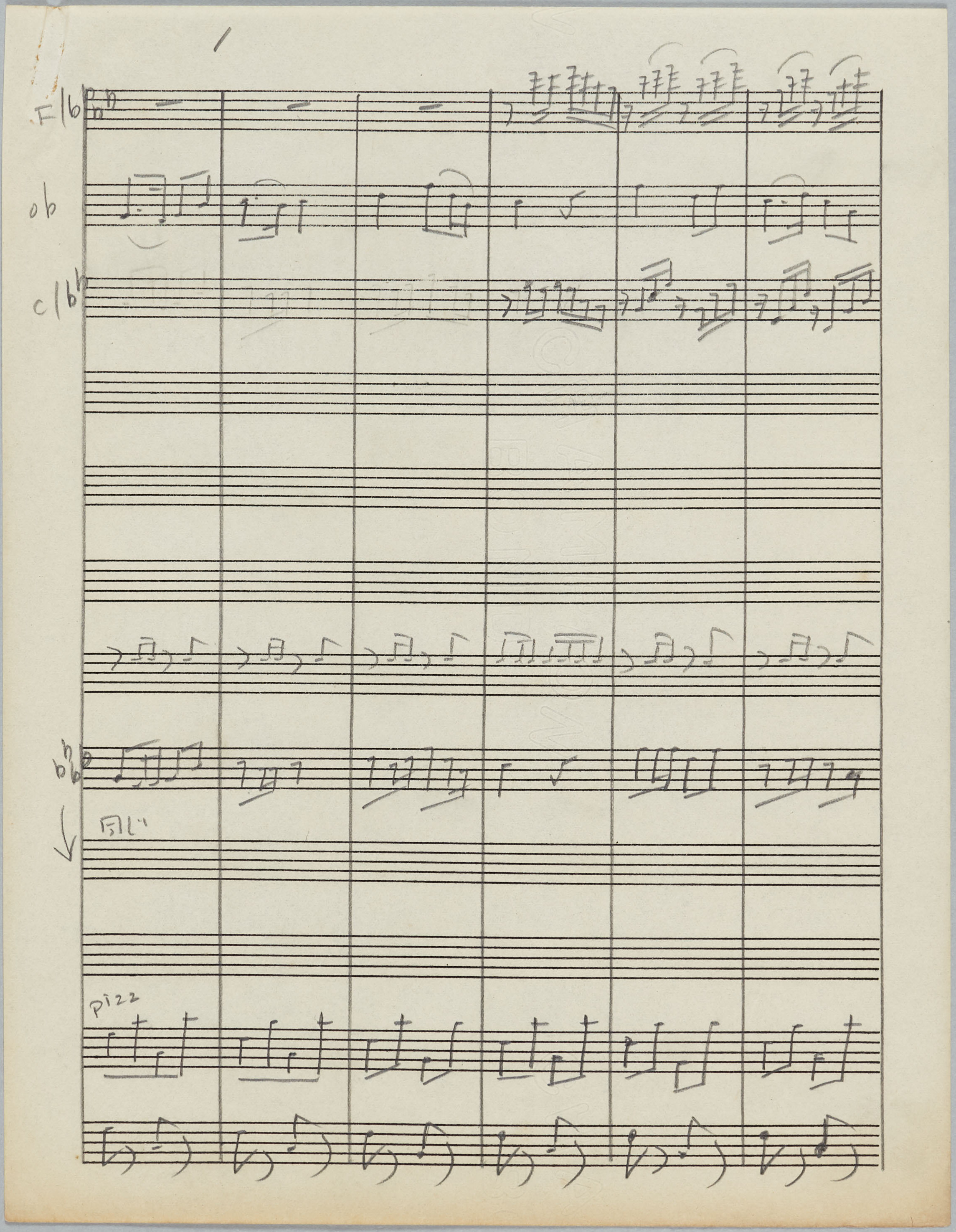
Gakufu fūraibō Kyū no suke no kyoku (Musical score: The song of
Kyunosuke the Wanderer) (cover, full score manuscript)[KRH47793_0001, 0025]
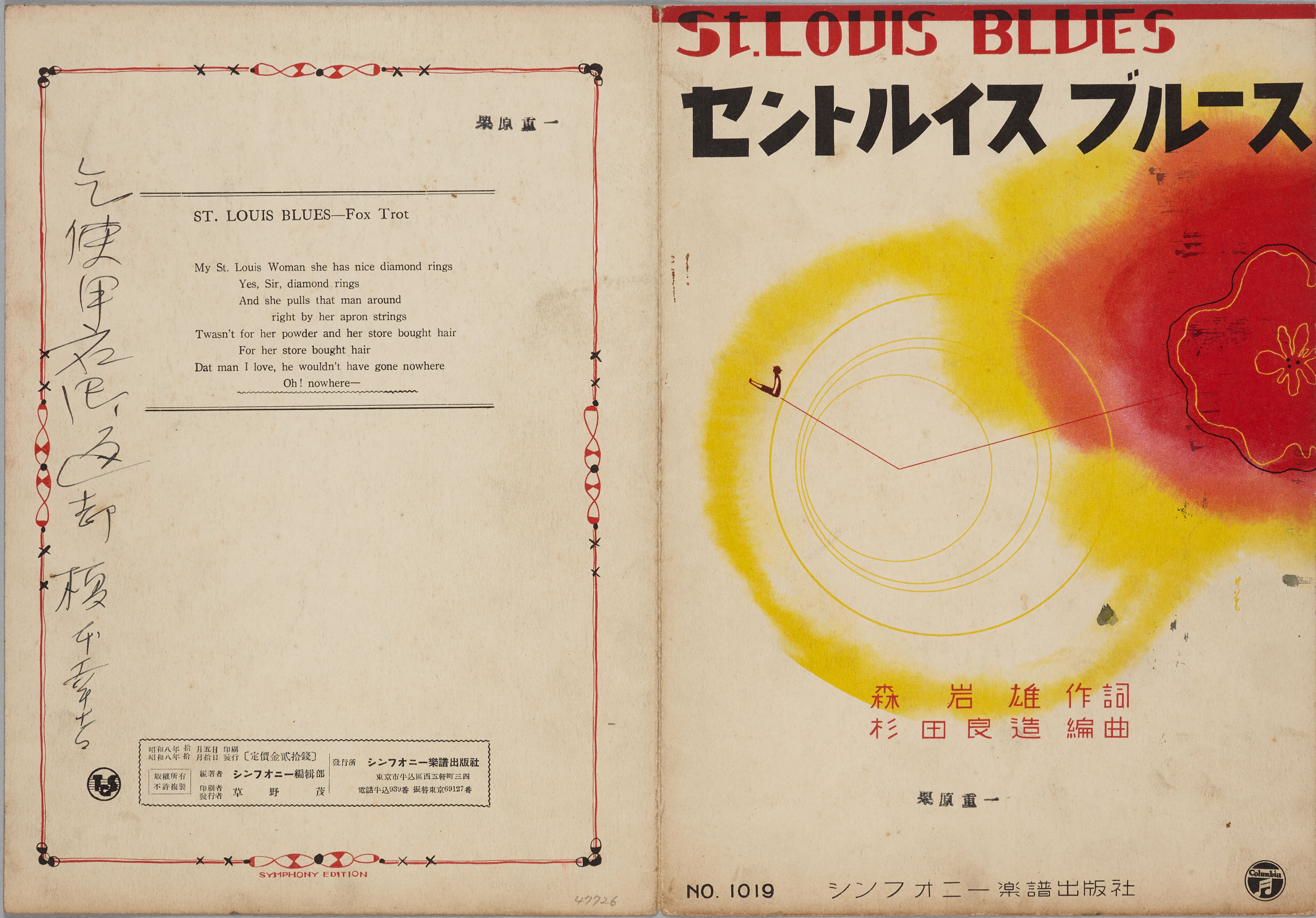
St. Louis Blues(cover)[KRH47726_0003]
Selected Research 3
The Basic Research of Silent Film Screenings Using Promotional Movie Materials
The Basic Research of Silent Film Screenings Using Promotional Movie Materials
Principal Researcher
Hidenori Okada (Chief Curator, National Film Archive of Japan)
Collaborative Researchers
Makiko Kamiya (Part-time Lecturer, Musashino Art University)
Kotaro Shibata (Junior Researcher, Theatre Museum, Waseda University)
Research Objectives
The purpose of this study is to survey movie theater flyers from the Taisho to the early Showa periods that are held by the Theatre Museum and, thereafter, comparatively study promotional materials from the same era held by the National Film Archive of Japan (hereafter NFAJ) and carry out the basic research of movie screenings in the Japanese silent film era. At that time, each theater had its own live performances, featuring its exclusive “benshi” narrator and musicians, as well as its own program. This makes it difficult to obtain a comprehensive understanding of screenings during the silent era; however, one step that may be taken is to examine the movie theater flyers and other promotional materials that are the subject of this survey. The aim of this study is to analyze these materials and, thereby, understand the actual circumstances of silentera film screenings.
Summary of Research
This year, we conducted a survey study of digitized images of approximately 1,000 movie theater flyers from the Taisho to the early Showa periods in order to gain a complete picture of all the target materials of this team and begin a full catalog of them. We also surveyed related materials held by other institutions, such as the NFAJ, and collected additional materials.
While there has been active research into early Japanese film screenings both in Japan and abroad,
there has been little recognition of the value of nonfilm (film-related) materials as a resource. Despite the likelihood that they could contribute to the further development of film studies, promotional movie materials such as theater programs and flyers have not necessarily been prioritized as subjects for collection and study. Consequently, they remain a subject that has not been sufficiently examined, even by the NFAJ. As such, we convened a study group (in-person and online) at the Theatre Museum on December 23 for a thorough preliminary examination of how to catalog these
materials. In this study group, a lecture was given by Yoriaki Sazaki (Research Collaborator/Visiting Curator of NFAJ) on the subject of “Cataloging the movie theater flyers from the Taisho to early Showa periods held by the Theatre Museum and using them for research: A comparison with the case of the NFAJ,” as well as an exchange of opinions on the new possibilities of film history research that can be facilitated by the survey and analysis of promotional movie materials. The study group also discussed the possibility of research related to musical scores (the Hirano Collection) formerly used in silent-era movie theaters and held by the Theatre Museum, and the need for comprehensive information
on silent-era movie theaters. A decision was made to embark on the latter by creating a list of silent era movie theaters, informed by movie yearbooks published at the end of the Taisho period.
The results of the above are scheduled to be presented by Hidenori Okada, Makiko Kamiya, Kotaro Shibata, and Fumito Shirai(Research Collaborator/Nagoya University of Foreign Studies)at an online symposium, held by the Theatre Museum and tentatively titled “Promotional Movie Materials Filling Gaps in Silent Film History in Japan,” on March 11.
Flyer of Asakusakoen Sanyu-kan in 1925[NFM075-001]
Flyer of Kanda Nikkatsu-kan in 1927[NFM001-001]
Selected Research 4
A Comprehensive Study of Actor Picture Books
Principal Researcher
Hiroyuki Kuwahara (Adjunct Researcher, Theatre Museum, Waseda University)
Collaborative Researchers
Hideyuki Iwata (Emeritus Professor, Faculty of Letters, Atomi University)
Masae Kurahashi (Project Researcher, Kinugasa Research Organization, Ritsumeikan University)
Tsugunao Katō (Associate Professor, Tokai University Center for Liberal Arts)
Chie Saitō (Adjunct Researcher, Theatre Museum, Waseda University)
Emi Nakamura (Visiting Researcher, Kinugasa Research Organization, Ritsumeikan University)
Asahi Kuwano (Staff, Japan High Performance Sports Center, Japan Sports Council)
Research Objectives
Actor picture books are compilations of kabuki actor portraits that also contain features that serve as actor directories. They have been published from the late seventeenth century through modern times, and make it possible to discover information about actors of every era. The purpose of this study is to survey and compile information on actor picture books from each period and use this image data to provide basic material for identifying actors from each era. This study compiles data that has been gathered as the result of successive research based, in particular, on the actor picture books owned by the Waseda University Theatre Museum, since they hold most of the well-known titles. We will then share the results, and publish a catalog as well.
Summary of Research
This fiscal year, the basic catalog of actor picture books, which was the primary objective of this study, was completed. This included 16 actor picture books in the possession of the Theatre Museum (26 books; 1,119 digital images). In addition to preparing the basic materials for research and publication, the coresearchers decided on their respective responsibilities and prepared content descriptions.
Actor picture books were mostly printed by woodblock and exist in multiple copies; therefore, many institutions have one or more various examples. The Theatre Museum’s collection, however, is remarkable in that it includes almost every book, and in many cases, multiple copies of each (in some cases, 10 or more copies of the same title). The survey results have also revealed that there are many books with excellent provenance. The survey confirmed that the former collection of Tsubouchi Shōyō includes the following titles: Yakusha gakuya tsū (“Actors in Their Dressing Rooms”), Yakusha sangaikyō (“Amusements of Actors on the Third Floor”), Yakusha sanjūnisō tengankyō (“Mirror Images of Thirty-Two Actor Faces”), Yakusha awase kagami(“Mirror Images of Actors”), Kabuki zōdan (“Chats on Kabuki”), Gekijō ikkan mushimegane (“A Look at the Theater through a Microscope”), and Daitokai kabuki Suikoden (“A Water Margin of Actors from the Three Capitals”). The former collection of Ihara Seiseien includes Yakusha sanjūnisō tengankyō (“Mirror Images of Thirty-Two Actor Faces”) and Kabuki zōdan (“Chats on Kabuki”). Meanwhile, Yasuda Zenjirō’s former collection includes a copy of Yakusha miburi himokagami (previously owned by Ishizuka Hōkaishi), and the former collection of Ishibashi Kanichirō has a copy of Ehon butai ōgi (“Picture-Book of the Stage in Fan Shapes”).
The former collection of Kōdō Tokuchi includes an annotated copy of Yakusha natsu no Fuji (“Actors Like Fuji in Summer”), illustrated by Katsukawa Shunshō (An’ei 9 [1780]). It is difficult to identify the actors in this book because their names are not transcribed; however, in this copy, the book’s former owner, kabuki aficionado Kōdō Tokuchi, inserted handwritten notes with the actors’ names, making it particularly valuable.
By carefully studying the contents of various volumes, we discovered a previously unknown book. The Theatre Museum owns two sets of Yakusha miburi himokagami formerly held by the Yasuda Library. One is believed to be a source of the book with the same title as the Kisho Fukusei Kai (Rare Book Facsimile Association) series, while the other was found to include a different, previously unknown book in the same format as Himokagami. Additionally, we confirmed valuable series. Shibai saiken sanbasō and Sanshibai saiken are also separately listed in the Union Catalogue of Early Japanese Books Database, but we found that they should be included in the same series. Also, they provide information that cannot be obtained from written commentaries and picture books, especially after Kunisada added illustrations that depicted portraits of actors appearing in the three major Edo theaters and stage maps reflecting actual performances at those theaters.
Next fiscal year, we plan to survey and photograph unphotographed works belonging to the Theatre Museum, as well as books held by other institutions, to continue the research and, ultimately, present the results of our compilation of basic data on actor picture books, including books not in the possession of the Theatre Museum.
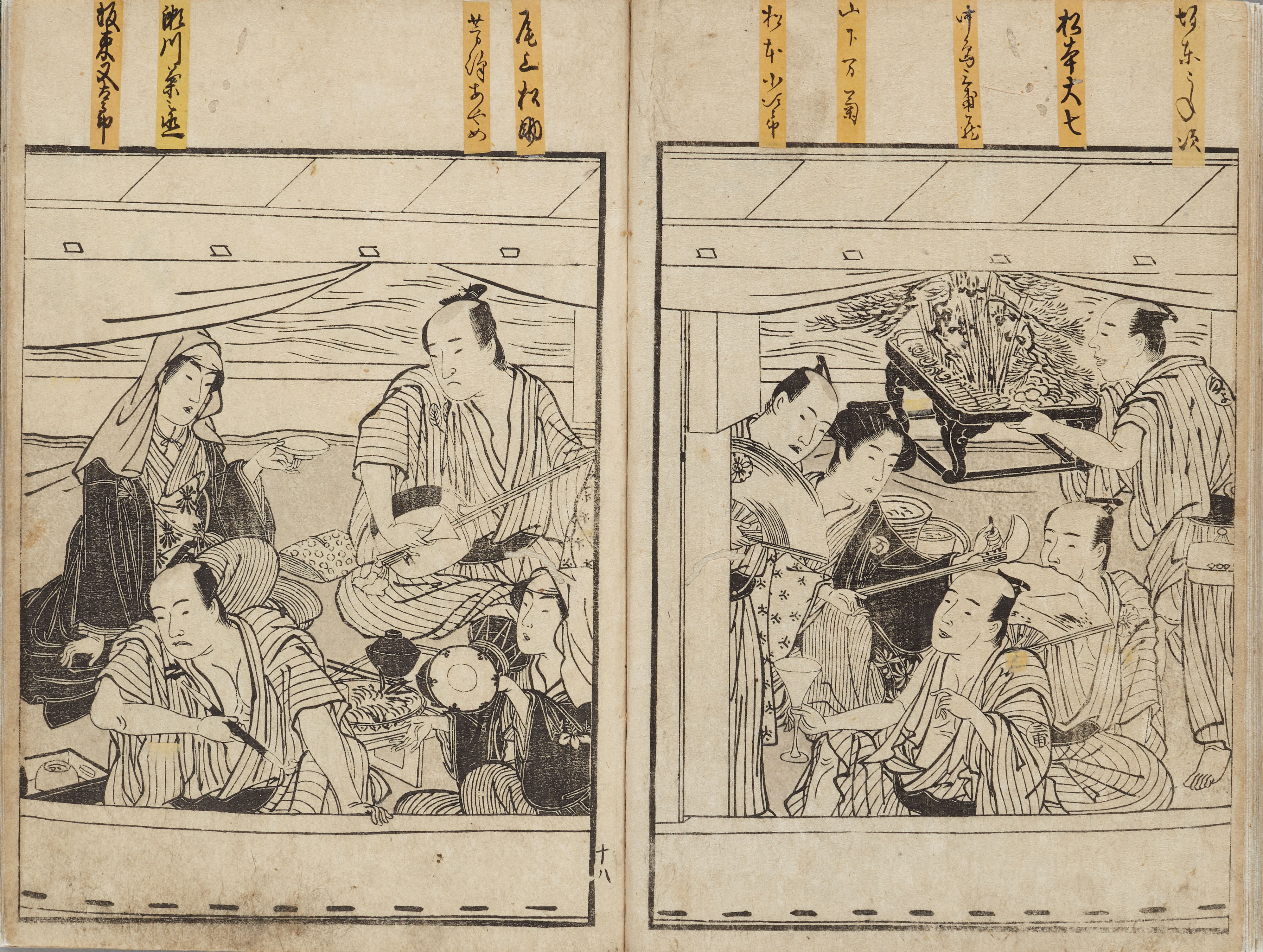
Annotations by Kōdō Tokuchi in Yakusha natsu no Fuji (Actors like Fuji in Summer), illustrated by Katsukawa Shunshō[ro15-00586_020]
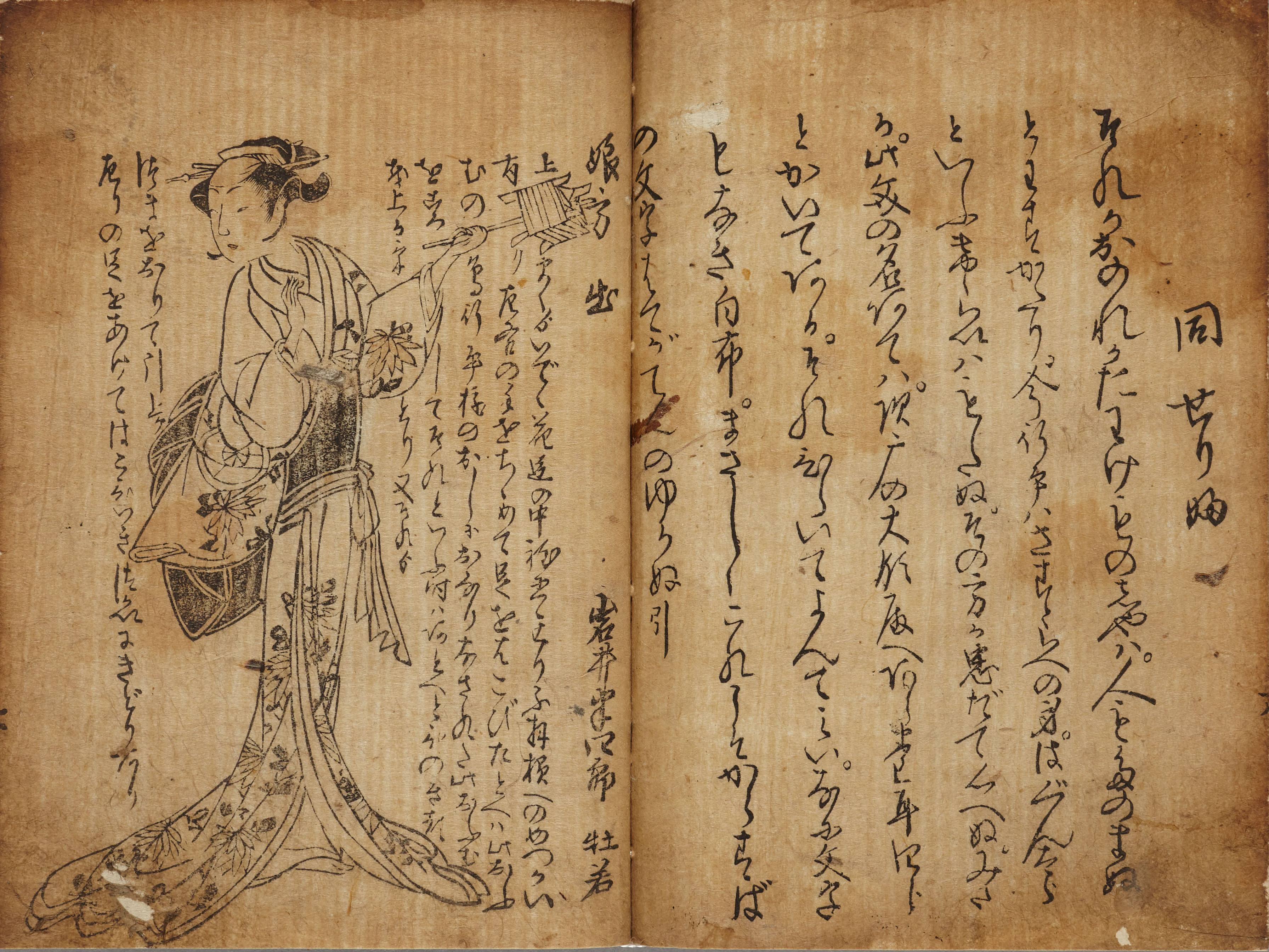
Double-page spread of a previously unintroduced book in the same format as and incorporated into Yakusha miburi himokagami[i11-00807_014]
Selected Research 5
The Basic Research of Tokiwazu-bushi Woodblock Printings Formerly Owned by Sakagawaya
Principal Researcher
Yuuichi Takeuchi (Professor, Research Institute for Japanese Traditional Music, Kyoto City University of Arts)
Collaborative Researchers
Eiichi Suzuki (Adjunct Researcher, Theatre Museum, Waseda University)
Ryou Tsuneoka (Director, Tokiwazu Association)
Satomi Abe (Part-time Lecturer, Musashino Academia Musicae)
Miho Maeshima (Part-time Lecturer, Tokyo University of the Arts)
Research Objectives
At the end of the Edo period in 1860, Sakagawaya inherited the rights to republish the tokiwazu-bushi (musical texts of kabuki plays) originally published by Igaya. It subsequently published new works in the Showa period and did not stop making woodblock printings of kabuki rehearsal books until 1987. Sakagawaya appears to have been one of only a few Edo period publishers who continued woodblock printing to the end, and even today, those in possession of these texts consist mostly of persons passing on tokiwazubushi who had to go to Sakagawaya for their rehearsal books. The purpose of this study is to examine the approximately 800 woodblocks held by Sakagawaya and, by creating and releasing a catalog, to obtain a complete picture of them all. We aimed to create a simple catalog with listings according to titles in 2020, followed by a detailed catalog according to each woodblock in 2021.
Summary of Research
Some 25 years ago, from 1994 to 1996, at the request of the current owners of the Sakagawaya prints that are the object of this study, Suzuki and Takeuchi conducted a preliminary survey of the collection. The results were reported at the 13th Meeting of The Japanese Society for the History of the Performing Arts in September 1996, along with a list of the titles appearing in the woodblocks. Shortly thereafter, the woodblocks were donated to the Waseda University Theatre Museum as a result of Suzuki’s efforts. However, due to their sheer volume, difficulties in handling, and the lack of
widespread digitization, they remained untouched in the Theatre Museum for a long time.
Thus, we first commenced with a survey study, examining any developments between the the preliminary survey and the donation of the woodblocks to the Theatre Museum, surveying the state of the preservation of materials from the time of their donation to the present, and then collating the Theatre Museum’s photographic data of the woodblocks against the actual items and their tracking numbers.
Despite of the heavy and bulky nature of the woodblocks, thanks to the effort of the staffs of the Theatre Museum, we were able to successfully collate photographic data with actual woodblocks and verify their current status. This led to the creation of a list matching shoot numbers and the old woodblock numbers, which was indispensable for catalog
compilation. We then checked for any incomplete photographic data (woodblocks that had either been left unphotographed or had no photographic data available), explored potential policies for future photography, and checked the preservation status of the woodblocks (whether there was any damage or deterioration).
The above work, existing photographic data, and data from the previously mentioned preliminary survey were combined to create a data ledger (database), which served as the basis for a simple catalog, which was the objective for 2020. This catalog will be published in the form of a booklet.
Looking towards the future in 2021, we will proceed with a careful bibliographical examination of each woodblock and use it to create a detailed catalog. In tandem, we shall consider the publishing system for tokiwazu-bushi practice books in terms of their woodblocks and pursue a multifaceted discussion of the significance and value of woodblocks in early modern Japanese music and, consequently, modern literary arts and society.
We would like to thank our research partners Gyo Shigefuji and Shiho Konishi for their assistance in bibliographic research of woodblocks and data creation.
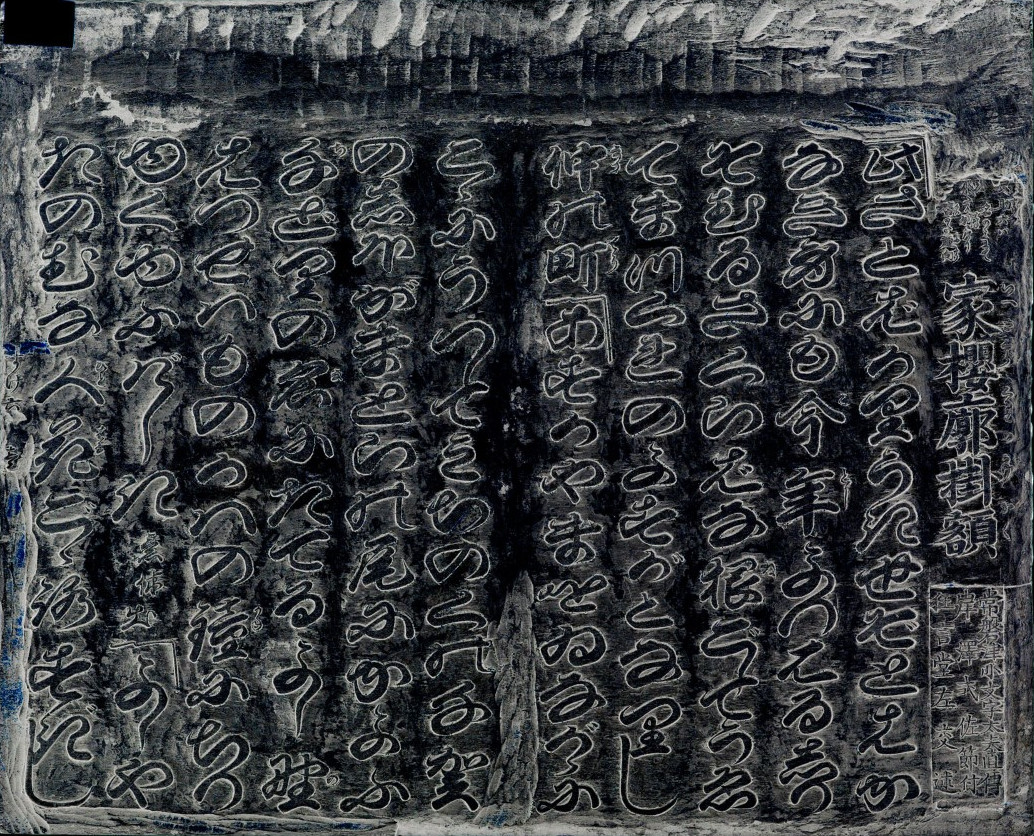
A woodblock that corresponds to the first printing of the tokiwazubushi practice book Iezakura kuruwanokakegaku (horizontally flipped photo). The text is engraved on both sides of the woodblock, and the song consists of four pages on two sheets (four sections of text in total). This song was used at the beginning of Sukeroku by Kikugoro Onoe V, which premiered at the Morita-za in March 1870 with lyrics by Kyogendo Sako and music by Kishizawa Shikisa VI, whose names are engraved under the title. The dancing still remained in the Yamamura style of Osaka. This is a work of the Kishizawa school during the time that the tokiwazubushi school of joruri and the Kishizawa school of shamisen were separate, and the woodblock displays signs that it was reprinted with the name tokiwazu-bushi added under the original title.[29888-737(31-01)]

